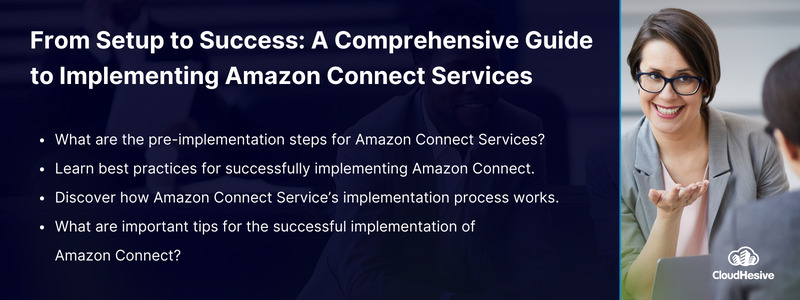
Keys to implementing Amazon Connect Services
Customer service life before Amazon Connect consisted of one of two options: Flipping through massive notebooks of instructions and using multiple tools to communicate, record, and manage call content and routing to Agents.
If you’ve been in the customer service field for 5 to 10 years, you likely remember the days of the multi-line phones blinking off and on as agents picked up calls. Calls would easily drop on transfer or get lost within a complex phone system.
Notes and procedures were gathered in notebooks or on computer files. Supervisors only got on a call when a customer was angry, and the relationship was likely already unsalvageable. Team collaboration was “over-the-wall” or in person. Many customers spent significant time “on hold” waiting for answers.
With Amazon Connect Services, everything an agent, customer service team, and supervisors need to support customers quickly and effectively is in one easy-to-use dashboard. Customers can communicate on multiple channels, and calls are managed with proper routing, so customers spend less time waiting. With Amazon Connect, customer service centers operate with higher quality and lower cost.
This article guides implementing Amazon Connect Service, including pre-implementation steps and best practices.

Pre-implementation steps for Amazon Connect Services
Migrating to or getting started anew with Amazon Connect Services takes planning. There are a few essential pre-implementation steps to consider, including:
- Evaluate objectives and goals for the system.
- Assess what technology the organization has and what it needs to have.
- Define your customer service and call center system requirements.
- Create an implementation plan or strategy to manage the process.
Preparation and planning are necessary to ensure a smooth, calculated transition that gets the running. Implementing Amazon Connect Services enables a team to reduce costs, improve agent and team productivity, and above all improve the quality of your customer service.
Once the team is trained and using Amazon Connect, you’ll be experiencing two significant benefits:
- First, customer data collection. By recording communications, teams can improve their level of service and better understand customer issues.
- Second, is business analytics. Having a growing set of customer service data provides real-time business analytics that can help guide business direction.
One essential part of this process is the decision to implement the system yourself or work with an Amazon business partner to design and implement it for you. Amazon offers demos, videos, and tutorials to help implement Amazon Connect on your own. Customers implementing the system on their own can also access full Amazon Connection documentation as well as blog channel content.
Amazon Connect implementation process includes:
- Creating an Amazon Connect account
- Configuring your Amazon Connect instance or server connection
- Inputting phone numbers and a routing plan
- Creating contact flows across the team
- Setting up accounts for agents
- Adding communication queues
- Set up outbound communications
- Integrating with additional AWS tools for handy add-ons or special tools needs
Amazon’s get started guides help you set up everything you need. When setting up your Contact Center instance keep in mind that one of the most important details is setting up the customer experience by creating flows. Amazon Connect contains a full set of default flows you can use. However, you should consider setting up customized flows specific to your business needs.
Don’t forget to assign agents access or permissions to interact with customers. Once all is set, remember to allow agents and supervisors time to train and experiment with the system. Providing hands-on training to agents may take some time to ensure a positive experience.
Best practices for implementing Amazon Connect Services
Amazon Connect Services provides several pre-built solutions to help get your new contact center up and running. However, those may not contain all the features necessary for your business needs. Best practices for implementing Amazon Connect include:
- Focus on your Flows (workflows)
- Optimize agent scheduling and workloads equitably
- Use additional tools like AWS Contact Lens to leverage AI and ML software for performance analytics
- Automate as many business processes as possible within your customer service center to improve productivity
Flows are critical because they control how customers move through your service system. Take the time to create simple flows that serve your needs and test them out when the system is live. Make the corrections needed and then retest until the customer flow matches your team’s needs. Be sure to use consistent attribute naming within all Amazon tools and services. Troubleshooting issues is faster when naming conventions are consistent.
Consider creating modular flows that are as simple as possible. Users can create multiple modular flows and then attach them to create a full workflow. Modular flows help reduce errors and maintenance. Be sure to set up recording behaviors.
Keep in mind Amazon Connect records conversations that include agents. For best results when routing calls, check your staffing block setup. Using check staffing blocks helps ensure proper communication routing to agents.
Be sure to double-check phone numbers. Verify you don’t have any infinite loops in your flow logic. Infinite loops mean the customer will never reach an endpoint. It’s important to check your flows and verify the customer connects to an agent or boot or is transferred appropriately.
Tips for a successful Amazon Connect implementation
Always start any implementation with a detailed plan. Use Amazon Connect training resources to fully understand how their tools can meet your needs. Define your needs or requirements and how you want to implement them. Plan for agent and management training and system experimentation before going live to production.
Plan to perform regular reviews on system flows to ensure customers are getting what they need. Continuously monitor agent performance to make sure everyone understands the system and how to provide quality customer service through the Amazon Connect dashboard tools and utilities.
Utilize the reporting and business analysis options within Amazon Connect. Don’t forget to also elicit feedback from customers. Customer feedback can help you find setup, flow, or training issues.


